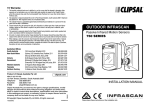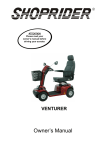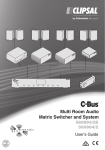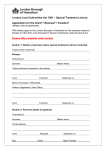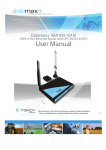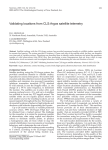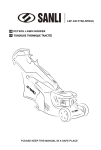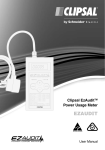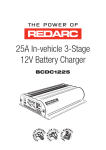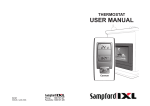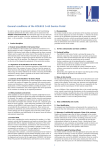Download 755DC Ionisation smoke alarm 9V DC battery
Transcript
Ionisation Smoke Alarm 9V DC Battery Operation User’s Manuall 755DC READ AND SAVE FOR YOUR SAFETY WARNING This smoke alarm will sound a short beep when power is connected. Do not use this smoke alarm with any external bug screens or smoke alarm guards. Use of these types of devices may cause a reduction in your smoke alarm response time. Smoke Alarms should be replaced every 10 years. Important Information About Your Smoke Alarm • Before installing your smoke alarm, you must read this entire User’s Manual. • Install a smoke alarm in each room and area of your home. See Section 3. • Smoke alarms cannot give you an early warning of fire or smoke unless you install, use, and maintain them by following these instructions. • You must hear the alarm’s warning sound and quickly respond to it to reduce the risk of damage, injury, or death that may result from a fire. • Your smoke alarm is packaged with the battery disconnected. Connect it to the battery leads before mounting the smoke alarm. • A smoke alarm will not work properly without a good battery installed correctly. The smoke alarm must be tested when a new battery is installed and every week after that. • A smoke alarm that beeps about once per minute means the battery is weak, and you need a new battery. Contents of This Manual 1. What Smoke Alarms Can Do. 2. What Smoke Alarms Will Not Do. 3. Where You Should Install Your Smoke Alarms. 4. Where You Should Not Install Smoke Alarms. 5. How To Install Your Smoke Alarm. 6. Weekly Testing of Your Smoke Alarm. 7. Taking Care of Your Smoke Alarm. 8. Replacing The Battery. 9. Using The Tamper Resistant Locking Mechanism. 10. Warranty Information. 11. Where To Send Your Smoke Alarm For Service. 1. What Smoke Alarms Can Do. Smoke alarms can only HELP protect your home and family against loss from a fire. The best protection is obtained by installing smoke alarms in each room, and each other area of the home. This will help make sure the people in the home will be able to hear and respond to the alarm sound. Warning Smoke Alarms may give you a warning of fire and smoke, but only if you install, use, and maintain them in accordance with these instructions. 2. What Smoke Alarms Will Not Do. A Smoke Alarm will not work without power. Your Smoke Alarm needs a good battery that is installed correctly to work. A Smoke Alarm will not work if its battery is missing, dead, or installed incorrectly. A Smoke Alarm will not sense a fire when the smoke cannot reach the Alarm. If a fire starts in a chimney, wall, roof, the other side of a closed door, or any other isolated area, the smoke alarm may not sense the smoke and will not give a warning. If you do not have an alarm in the bedroom, and sleep with the door closed, a fire inside the bedroom may not sound the alarm located in another room. Therefore, a Smoke Alarm must be placed both inside and outside all bedrooms. A Smoke Alarm will not promptly sense a fire except in the area or room in which the Smoke Alarm is located. For example: a. A Smoke Alarm may not sense a fire on another level of a residence or building. A second-floor smoke alarm may not detect a fire on the first floor or basement of a building. Therefore, smoke alarms must be installed on every floor or level of your home or building. b . If the Smoke Alarm is located on a different level to the bedrooms, or in an isolated area of the house or residence, it is less likely to wake up people sleeping in the bedrooms. All types of Smoke Alarms have limitations, no type of Smoke Alarm can sense every kind of fire or smoke every time. Ionisation smoke alarms (such as this unit) are your best overall choice for reliability and fast response time since they quickly sense small “invisible” smoke particles and also sense large “visible” smoke particles. NOTE: Photoelectric smoke alarms may respond faster in certain types of fires. For example, slow smouldering fires with large “visible” smoke particles. For additional protection, the use of multiple smoke alarms and heat detectors is recommended. You should use both battery powered and direct wired 240 volt AC powered smoke alarms. Since a Smoke Alarm will not work without power, having alarms that work from two different power sources can give you extra protection in case of a dead battery or an AC power failure. Using a smoke alarm in a smoky area like a kitchen, or in a high humidity area near a shower can cause false alarms. Do not remove your battery to quiet the Alarm. Do not take the Alarm down. Do not switch off the power to the Alarm. If you have a false alarm, try waving a towel near the Alarm to clear the sensing chamber. A Smoke Alarm will not help protect you if it is not powered, or the unit is removed. A Smoke Alarm may not always warn you about fires caused by carelessness or safety hazards such as smoking in bed, violent explosions, escaping gas, improper storage of flammable materials, over-loaded electrical circuits, natural causes such as lightning, children playing with matches, and arson. Fire prevention is your best safeguard. Installing smoke alarms may make you eligible for lower insurance rates, but SMOKE ALARMS ARE NOT A SUBSTITUTE FOR INSURANCE. Home owners and renters alike should continue to insure their lives and properties. 3. Where You Should Install Your Smoke Alarms. Smoke detectors shall be installed outside of each separate sleeping area in the immediate vicinity of the bedrooms and on each additional storey of the family living unit including basements and excluding crawl spaces and unfinished attics. The following information will help you safely locate your Smoke Alarms: • Do install your smoke alarms in accordance with all applicable laws, regulations, standards, and codes. • Do install a smoke alarm in the hallways outside of every bedroom area. If the bedroom has a door, there must be a smoke alarm inside and outside the bedroom. See Figure 1. If your home or residence has two bedroom areas, a smoke alarm must be placed outside the second bedroom area and inside the bedroom(s) if they have doors. See Figure 2. Figure 1 · - Denotes smoke alarm Figure 2 If your household or residence has several floors, there must be an alarm on every floor, including the basement. See Figure 3. Figure 3 - Denotes smoke alarm • Do install basement smoke alarms at the bottom of the basement stairwell. • Do install a smoke alarm in every bedroom where a smoker sleeps. • Do install a smoke alarm in every room and bedroom where electrical appliances (such as portable heaters, humidifiers, or electric blankets) may be operated while someone sleeps. • Do install a smoke alarm inside every bedroom where someone sleeps with the door closed. Smoke can be blocked by the closed door, or the alarm may not wake the sleeper if the door is closed. • Do install smoke alarms at both ends of a bedroom hallway if it is more than 10 metres long. • Do install second floor smoke alarms at the top of the first-to-second floor stairwell, as long as no door or obstruction blocks the path of the smoke to the alarm. • Do install a smoke alarm in a room where flammable household chemicals or solvents are stored. For example, if you keep kerosene, paint thinner, or certain types of contact cements within your residence, install a smoke alarm in that room, unless not recommended by a situation described in Section 5. • Do install smoke alarms on the ceiling no closer than 300mm to any wall or corner, or on the wall at least 300mm but no more than 500mm from the ceiling. See Figure 4. • If your ceiling has radiant heat or has a lack of insulation to the outside, ceiling mounting of your smoke alarm is not advisable due to temperature variations. You should follow the wall mounting procedures. • If you have a peaked, sloped, gabled or cathedral style ceiling, mount your smoke alarm 500mm to 1500mm - measured horizontally from the highest point - on the ceiling as shown in Figure 4. Figure 4 4. Where You Should Not Install Smoke Alarms: • Do not install a smoke alarm within close proximity of heating and cooling supply vents or within close proximity of return or fresh air vents. Smoke may be blown away from the smoke alarm by the supply vents, or could be diffused or reduced by being diverted into the return air vent. • Do not install your smoke alarm in an area where the temperature may fall below 5°C, or rise above 45°C. Smoke alarms are designed to work safely only within these temperature ranges, and failure to alarm, improper alarms, or nuisance alarms may result from operation outside these temperature limits. • Do not install a smoke alarm in a damp or very humid area such as bathrooms with showers, where the normal humidity may rise beyond 93% Relative Humidity. Above this level, moisture may condense inside the smoke chamber and cause wrong or false alarms. • Do not install a smoke alarm in an area where particles or combustion are normally present, such as kitchens or automobile garages. • Do not install a smoke alarm in dusty or dirty areas; Such an installation cannot be relied upon. An accumulation of dust and dirt in the sensing chamber may block the openings and prevent an alarm, or may get inside the alarm and cause false alarms. If a smoke alarm is required in such an area, vacuum it frequently and test it according to Section 7. • Do not install a smoke alarm in the dead air space in the corner where the wall meets the ceiling. If in doubt as to the exact location of mounting, contact your local fire brigade for help in choosing a location. • Do not install a smoke alarm where bugs or insects are present before eliminating or minimizing the bug problem. Although all smoke alarms built since 1986 are made to prevent bugs from entering the detection chamber, bugs may build up on chamber openings and prevent smoke from entering. As a result, unit should be vacuumed frequently as explained in Section 7. • Do not install a smoke alarm within close proximity of a fluorescent light. Electrical “noise” may cause nuisance alarms. Cut along dotted line $ IMPORTANT INFORMATION SMOKE ALARM SAFETY CHECK LIST Pin this up close to your smoke alarm in an easy to read location and review both sides often. Before installing, using, and maintaining your smoke alarm read the entire User ’s Manual, and Warranty, and then keep it in a convenient location for your reference. 1 . Test your smoke alarm every week. To test the electronics, firmly depress the button. To test that smoke reaches the sensor, blow smoke in a careful, fire-safe manner into your smoke alarm. 2 . Your smoke alarm will not work without power. Never shut off its power or remove the battery to quiet the alarm. For battery powered units: When your smoke alarm “beeps” about once a minute, the battery is weak. Immediately install a new battery correctly. Be sure to use only batteries specified in manual or on unit. Test unit after installing a new battery. 3 . Clean and vacuum the openings on your smoke alarm once a month. 4 . Do not open the smoke alarm or try to repair it. For replacement information see Warranty in User’s Manual. 5 . Verify you have the proper number of smoke alarms in your home and the correct location for each one. A smoke alarm will not respond well in an incorrect location. 6 . Smoke alarms have technical limitations and may not respond in all situations. FIRE PREVENTION is your best safeguard. 7 . For a replacement User’s Manual or Safety Check List, please indicate your unit Model, include a self-addressed stamped envelope and send to: Gerard Industries Pty Ltd 12 Park Terrace Bowden, South Australia 5007 For product service information, please see Warranty in User’s Manual. I nstalling, testing, and taking care of smoke alarms is just one step in helping to protect your family and home from fires. You must also reduce the chance that fires will start in your home and increase your chances of escaping if one does start. For your safety, at a minimum, you should do the following to have a more effective fire safety program. a) Follow safety rules and prevent hazardous situations. • Use smoking materials properly - never smoke in bed or when sleepy or under the influence of alcohol or other drugs. • Keep matches and other fire starters away from children. • Store flammable materials in proper containers and never store or use them near open flames or sparks. • Keep electrical appliances and cords in good working condition, and do not overload electrical circuits. • Keep stoves, fireplaces, chimneys, and barbecue grills clean and make sure they are properly installed away from combustible materials. • Keep portable heaters and open flames such as candles away from combustible materials. • Do not allow rubbish to accumulate. b) Develop a family escape plan and practice it regularly with your entire family, especially small children: • Draw a floor plan of your home and find TWO ways to exit from each room. There should be a way to get out of each bedroom without opening the door. • Teach children what the smoke alarm signal means, and that they must be ready to leave the home or residence by themselves if necessary. Show them how to check to see if doors are hot before opening them, how to stay close to the floor and crawl, and how to use the alternate exit if a door is hot and should not be opened. • Decide on a meeting place a safe distance from your house and make sure all your children understand they should go and wait for you there if there is a fire. • Hold fire drills every 6 months to make sure everyone, even small children know what to do to escape safely. • Know where to go to call the fire department from outside your residence. • Provide emergency equipment, such as fire extinguishers, and teach your family how and when to use this equipment. c) What to do if there is a fire in your home: After you have prepared family escape plans and practiced them with your family, you have increased their chances of escaping safely. Review the following rules with your children when you have fire drills so everyone will remember them in a real smoke or fire emergency. • Don’t panic, stay calm. Your safe escape may depend on thinking clearly and remembering what you have practiced. • Get out of the house following your planned escape route as quickly as possible. Do not stop to collect anything or to get dressed. • Open doors carefully only after feeling to see if they are hot. Do not open a door if it is hot; use an alternate escape route. • Stay close to the floor, smoke and hot gases rise toward the ceiling. • Keep doors and windows closed unless you open them to escape and reclose them as you leave. • Meet at your pre-arranged meeting place after leaving the house. • Call the Fire Brigade as soon as possible from outside your house. Give the address and your name. • Never re-enter a burning or smoke-filled building. Contact your local Fire Brigade for more information on making your home safer from fires and about preparing your family’s escape plans. $ Cut along dotted line OTHER THINGS YOU CAN DO TO MAKE YOUR FAMILY AND HOME SAFER FROM FIRES: 5. How To Install Your Smoke Alarm: After having carefully read the introduction and Sections 1 to 4, you are now ready to install your smoke alarm. Please follow these directions: 5.1 Unlock and remove mounting bracket from smoke alarm with an anti-clockwise twist. 5.2 Place mounting bracket on ceiling or wall in prearranged location and use pencil to trace two opposing hole positions for mounting screws. Drill two 1.6mm holes. 5.3 Use mounting screws provided for attaching to studs or woodwork. For plaster or plasterboard, you may wish to use the plastic anchors provided and screws. 5.4 Screw mounting bracket to surface securely. NOTE: Before mounting alarm on a wall, be sure arrow on mounting bracket is pointing up toward ceiling. 5.5 Install battery. (See Replacing The Battery. Section 8). 5.6 Attach smoke alarm to mounting bracket with a clockwise twist until it snaps into locked position. PLEASE NOTE: Your smoke alarm is designed with a safety mechanism that prevents mounting unless a battery is installed. This helps assure the alarm is functional when mounted. 5.7 You have now finished installing your smoke alarm. For your safety, proceed with testing described in next section. Figure 5 6. Weekly Testing Of Your Smoke Alarm 6.1 For a complete weekly test of the electronics and the ionisation sensor operation, firmly depress the test button on the cover of the smoke alarm for a few seconds. The smoke alarm will sound by making a continuous loud “beeping” noise. The smoke alarm will stop sounding when you release the button. 6.2 For a complete weekly test to assure that smoke will reach the ionisation sensor and that the sensor is not plugged with grease, dirt, dust, grime, insects, or any type of obstruction, you must test in a careful, fire safe manner by blowing smoke directly into the smoke alarm until the alarm sounds. Never use an open flame of any kind. You may ignite and damage the smoke alarm or your home. The smoke alarm will stop sounding when the smoke is cleared from the heat sensing chamber. Blowing or fanning fresh air into it will help clear it. 6.3 IMPORTANT: Always test your smoke alarm upon returning from holidays, or any other time when no one has been in your household or residence for several days. 6.4 If a smoke alarm is installed in a mobile home, test the smoke alarm after you remove the vehicle from storage and before each trip. WARNING: If your Smoke Alarm does not respond as described in any of the above tests, chech that a good battery is properly installed. If a good battery is properly installed, promptly remove the unit, repack it and return it for repair or replacement (See Section 11). 7. Taking Care Of Your Smoke Alarm Your smoke alarm has been designed and manufactured to be as maintenance free as possible. Here are a few simple steps you must perform, in addition to the weekly test s described in Sect ion 6, to keep your unit in good working order: • The smoke alarm should be vacuumed monthly or more often if there is dust, dirt, or kitchen grease that can accumulate. Use a soft brush or wand attachment and vacuum all slots in the cover and side. For your safety, you must properly clean and maintain your smoke alarm, since a dirty or malfunctioning unit may fail to alarm or cause unwanted nuisance alarms. • If the unit is damaged or fails to operate properly, and you have checked that a good battery is installed correctly, follow the directions in Section 8 for return. FOR YOUR SAFETY: DO NOT OPEN THE SMOKE ALARM AND TRY TO REPAIR I T YOURSELF. While smoke alarms are economical devices, they contain precision electronic components that are precisely calibrated. Repair must be done by the manufacturer. 8. Replacing The Battery: The smoke alarm will sound “beep” for at least 30 days when the battery is weak. The battery must be immediately replaced with a good fresh one. The battery should also be changed if it does not sound an alarm when tested. TO REPLACE THE BATTERY: 8.1 Check if the tamper resist locking pin is installed in the smoke alarm (see Section 9). If so, pull the pin completely out of the smoke alarm using long nose pliers. 8.2 Remove the smoke alarm from the mounting bracket by twisting anti-clockwise. 8.3 Replace with a fresh battery. 8.4 Check that battery connections are secure and the battery is secured in its compartment. 8.5 Test smoke alarm for proper operation (see Section 6). The smoke alarm operates on a 9 volt battery. The normal battery operating life will be (1) one year. The life of some batteries may be less. Use Eveready 216, 552 or 1222. Mallory MN1604, and Duracell MN1604 only. CAUTION: Do not use any type of rechargeable batteries. 9. Using The Tamper Resistant Locking Mechanism: To make the smoke alarm somewhat tamper resistant, a “locking pin” has been provided in the base of the unit. It will deter a child or other individual from removing the smoke alarm from the bracket. See Figure 6. This can be installed by the following directions: LOCKING PIN Figure 6 9.1 9.2 9.3 9.4 Remove the break away locking pin from the unit by rocking pin back and forth. Put the smoke alarm back on the mounting bracket. (See Section 5 on How To Install Your Smoke Alarm). Using long nose pliers, grab the head of the locking pin and insert into hole located on the side of the smoke alarm. See Figure 6. To expose the hole, break away plastic with long nose pliers. The Tamper Resistant feature is now installed and complete. To remove: 9.5 Using long nose pliers, grasp the head of the locking pin and pull the pin completely out of the smoke alarm. 9.6 The smoke alarm can now be removed from the mounting bracket with an anti-clockwise twist. Figure 7 Notes 10. Warranty 1 . The benefits conferred herein are in addition to, and in no way shall be deemed to derogate: either expressly or by implication, any or all other rights and remedies in respect to this Clipsal Product, which the consumer has under the Commonwealth Trade Practices Act or any other similar State or Territorial laws. 2 . The Warrantor is Gerard Industries Pty Ltd, 12 Park Terrace, Bowden, South Australia, 5007. Telephone (08) 8269 0511. With registered offices in all Australian States. NSW 122 Canterbury Road, Padstow 2211 Telephone (02) 9794 9200 VIC 83-89 Queens Parade, North Fitzroy 3068 Telephone (03) 9207 3200 QLD 919 Nudgee Road, Nudgee 4014 Telephone (07) 3244 7444 WA 23 Truganina Road, Malaga 6090 Telephone (08) 9442 4444 TAS 55 Lampton Avenue, Derwent Park 7009 Telephone (03) 6272 3177 NT 16 Albatross Street, Winnellie 0820 Telephone (08) 8947 0278 3 . This Clipsal Product is guaranteed against faulty workmanship and materials for a period of two (2) years from the date of installation. 4 . Gerard Industries Pty Ltd reserves the right, at its discretion, to either repair free of parts and labour charges, replace or offer refund in respect to any article found to be faulty due to materials, parts or workmanship. 5 . This warranty is expressly subject to the Clipsal Electronic Product being installed, wired, tested, operated and used in accordance with the manufacturer’s instruction. 6 . All costs of a claim shall be met by Gerard Industries Pty Ltd, however, should the product that is the subject of the claim be found to be in good working order all such costs shall be met by the claimant. 7 . When making a claim the consumer shall forward the Clipsal Electronic Product to the nearest office of Gerard Industries Pty Ltd together with adequate particulars of the defect within 28 days of the fault occurring. 11. Where To Send Your Smoke Alarm For Service: If repair or service is required, return the smoke alarm to the address below, by courier, in a well padded box. Sending by Australia Post is not permitted, and alternate disposal is not allowed. Product of Gerard Industries Pty Ltd ACN 007 873 529 F1567 12 Park Terrace, Bowden, South Australia 5007 Telephone (08) 8269 0511 Facsimile (08) 8340 1724 Internet http://www.clipsal.com.au E-Mail [email protected]













